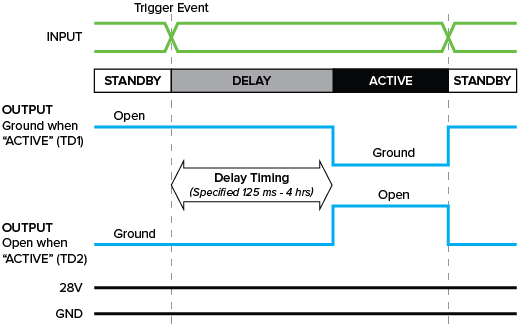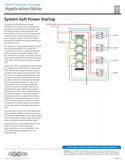
The NEXSYS Time Delay is a Series A (4 pin) device that detects a signal level state change as the event which triggers the delay timer to start. The Time Delay also has the option to start the delay timer upon power-up.

28V: Operating voltage (nom.), 4 mA current draw (max.). Device can be specified to start delay timer on power-up.
GND: Continuous Ground required.
INPUT: The INPUT level determines if the device is in STANDBY or DELAY/ACTIVE mode. The device can be specified to transition to DELAY/ACTIVE mode by an INPUT level state change. The INPUT level state options include +28 VDC, High Impedance, and Ground. INPUT is unused when device is specified as a power-up delay timer.
OUTPUT: The Time Delay offers two output options, based on the state of the OUTPUT signal when ACTIVE. The specified delay timing options range from 125 ms to 4 hours. The output load capacity is 0.5 A (Resistive).
Time Delay (TD1): Ground when ACTIVE and High Impedance when in STANDBY or DELAY.
Time Delay (TD2): High Impedance when ACTIVE and Ground when in STANDBY or DELAY.
To help system designers understand the potential of NEXSYS Component Technology, we have assembled a collection of Application Notes. The links below show example applications that utilize the Time Delay component.
System Soft Power Startup
 This application diagram depicts a power distribution control system with a staggered startup using incremental time delay components. The custom sequential startup pattern ensures that certain units are powered up before others and protects power supplies from transient spikes.
This application diagram depicts a power distribution control system with a staggered startup using incremental time delay components. The custom sequential startup pattern ensures that certain units are powered up before others and protects power supplies from transient spikes.